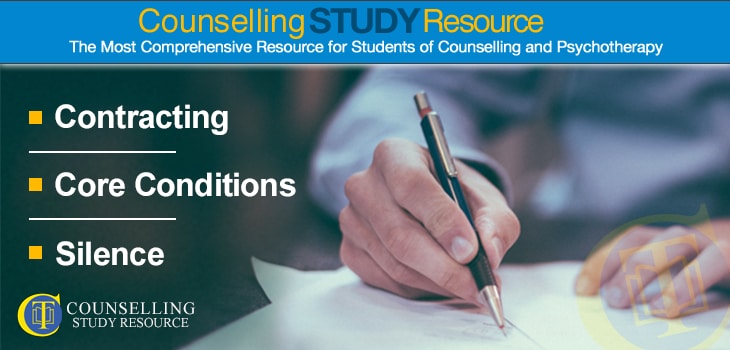001 – Contracting – Core Conditions – Silence
In this first episode of the Counselling Tutor Podcast, Ken Kelly and Rory Lees-Oakes speak about contracting as a counsellor. ‘Theory with Rory’ looks at the core conditions of Carl Rogers; and in the skills section, Ken introduces the power and benefits of silence.
The Counselling Contract
As counsellors, we are expected to contract with our clients before therapy begins. The British Association for Counselling and Psychotherapy (BACP) recognises contracting in the counselling relationship as part of client autonomy, offering respect for the client’s right to be self-governing.
Rory and Ken discuss what contracting is and why we need a written contract, showing how this empowers the client. They look at how legislation affects the content of a therapeutic contract, and how the four-corners rule applies to us as counsellors. They also explain what to do when your agency’s contract seems not to fit with the BACP Ethical Framework.
The Core Conditions of Carl Rogers
Rory sets the scene by talking about the origins of humanistic psychology, and how it differs from the other two main schools of psychology – psychoanalysis (associated with Sigmund Freud) and behaviourism (BF Skinner). Key names in the development of humanistic psychology were Abraham Maslow, Rollo May, and of course Carl Rogers.
Rory then explores the three ‘core conditions’, a term coined in the 1970s and 1980s by the British person-centred movement. In fact, Rogers had listed six conditions as being necessary and sufficient to bring about therapeutic change in a client:
- that the counsellor makes psychological contact with the client (i.e., they are ‘on the same page’ psychologically)
- that the client is incongruent (vulnerable or anxious)
- that the counsellor is congruent (genuine)
- that the counsellor experiences unconditional positive regard (UPR) – non-judgemental warmth and acceptance – towards the client
- that the counsellor feels empathy towards the client
- that the client receives the congruence, UPR and empathy of the counsellor.
Referring to Tony Merry’s book Learning and Being (PCCS Books, 2002), Rory links the six conditions to ethics, as they can act as a checklist in helping the therapist to decide whether or not therapy can take place.
Rory examines each of the three core conditions in more detail, providing an overview of the important role played by empathy, UPR and congruence in the counselling relationship. He also shines a light on the hidden conditions, explaining the importance too of psychological contact, the client being incongruent, and the client perceiving (at least at some level) the presence of empathy and UPR from the counsellor.
Numbers 3, 4 and 5 of the conditions are known as the ‘core’ (or the ‘facilitative’ or the ‘counsellor’s’) conditions, as opposed to the ‘hidden’ (or the ‘client’s’) conditions (numbers 1, 2 and 6).
It is useful for us, as counsellors, to develop a ‘volume control’ on our ability to demonstrate the core conditions, with the dial set at full in the counselling room, but toned down as appropriate when dealing with others in everyday life.
Free Handout Download
Counselling Contract Checklist
Use of Silence in Counselling
Silence may be challenging for some counselling students – in our culture, people often talk about the need to ‘fill an awkward silence’. But in the counselling room, silence provides essential time for processing to occur.
Ken delves deep into the meaning of silence, and how the skill can be used effectively in the counsellor–client relationship, benefiting both parties. For example, silence is directly linked to the counsellor having UPR for the client, and it allows the client to set the pace of the session, and to trust they will find their own way without needing the counsellor to lead them.
